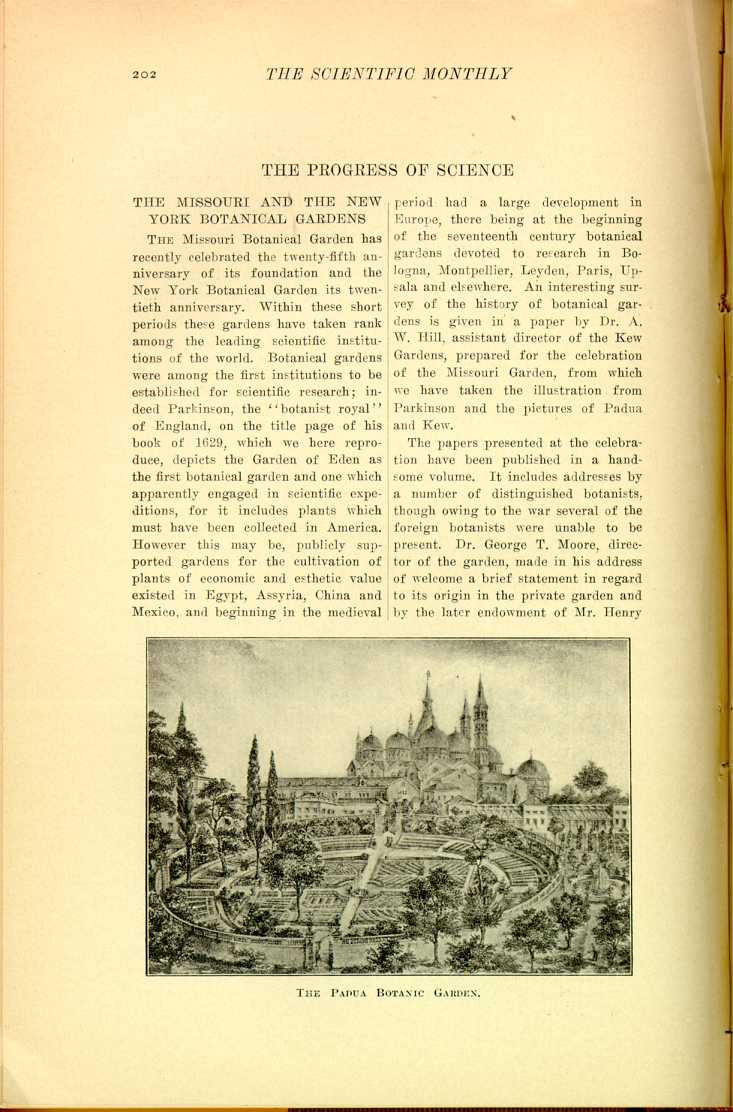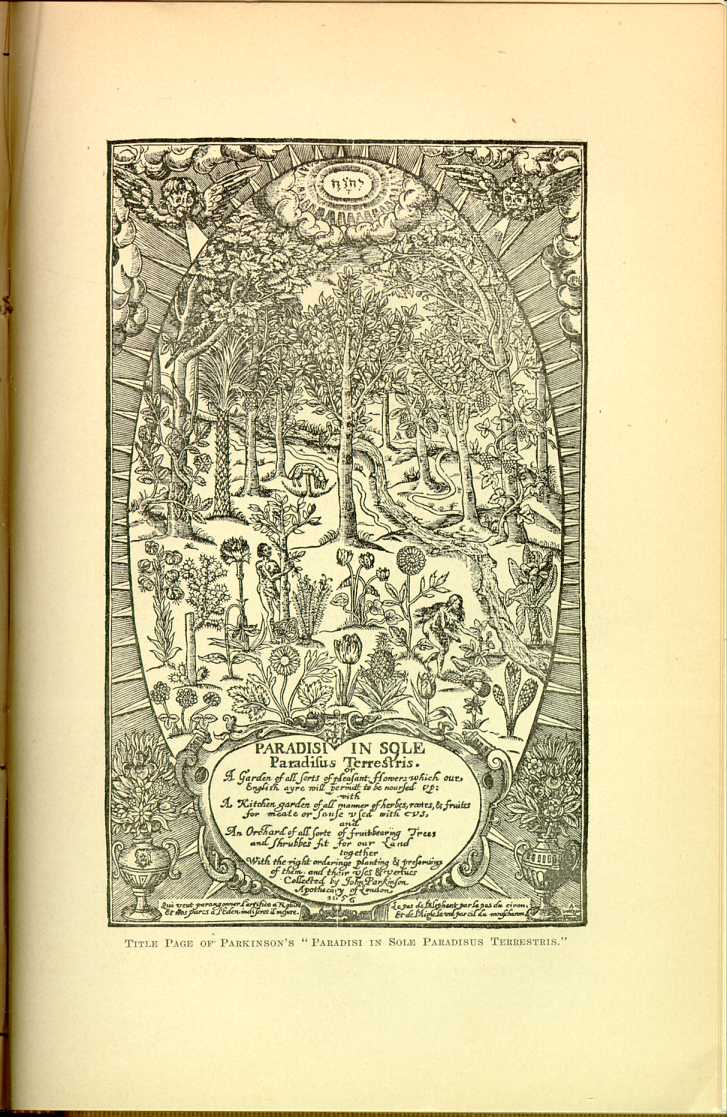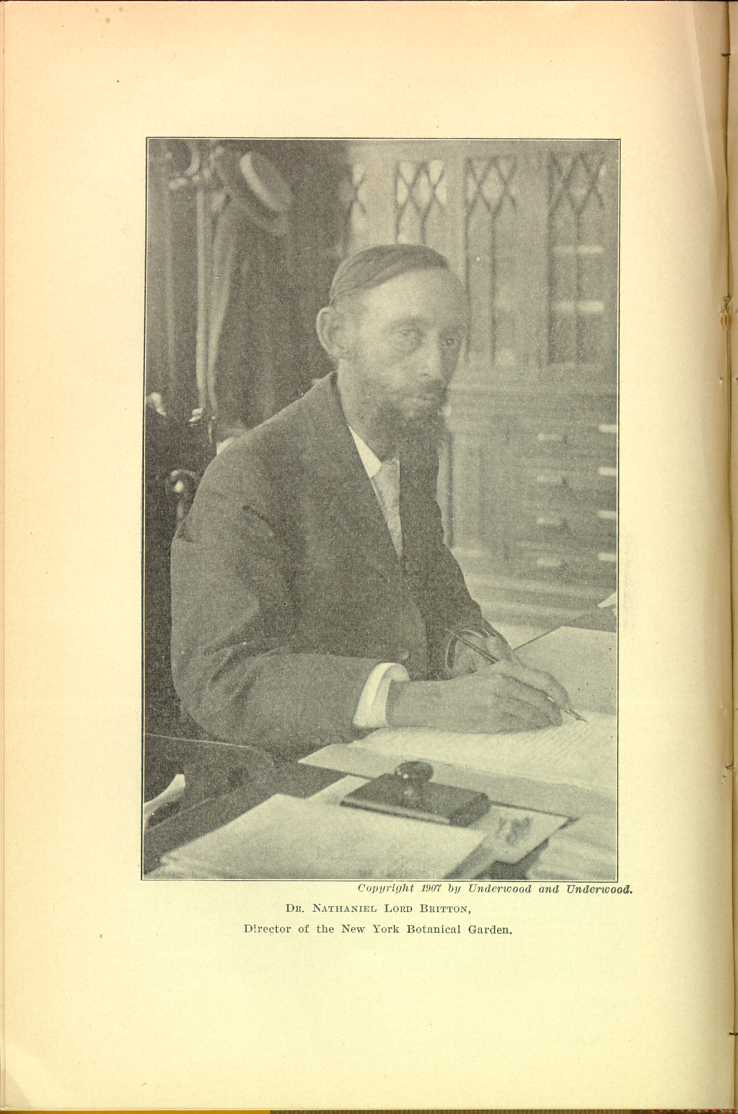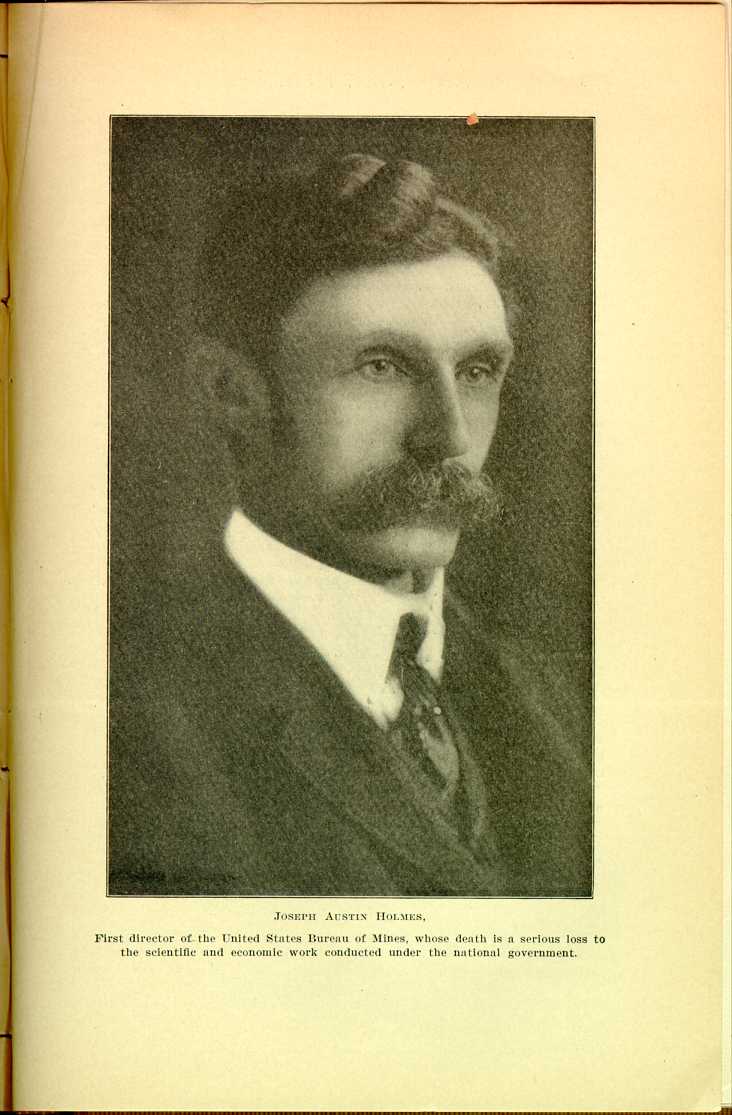| The Scientific Monthly | ||
THE PROGRESS OF SCIENCE
THE MISSOURI AND THE NEW
YORK BOTANICAL GARDENS
THE Missouri Botanical Garden has recently celebrated the twenty-fifth anniversary of its foundation and the New York Botanical Garden its twentieth anniversary. Within these short periods these gardens have taken rank among the leading scientific institutions of the world. Botanical gardens were among the first institutions to be established for scientific research; indeed Parkinson, the "botanist royal'' of England, on the title page of his book of 1629, which we here reproduce, depicts the Garden of Eden as the first botanical garden and one which apparently engaged in scientific expeditions, for it includes plants which must have been collected in America. However this may be, publicly supported gardens for the cultivation of plants of economic and esthetic value existed in Egypt, Assyria, China and Mexico and beginning in the medieval period had a large development in Europe there being at the beginning of the seventeenth century botanical gardens devoted to research in Bologna, Montpellier, Leyden, Paris, Upsala and elsewhere. An interesting survey of the history of botanical gardens is given in a paper by Dr. A W. Hill assistant director of the Kew Gardens, prepared for the celebration of the Missouri Garden, from which we have taken the illustration from Parkinson and the pictures of Padua and Kew.
The papers presented at the celebration
have been published in a handsome
volume. It includes addresses by
a number of distinguished botanists,
though owing to the war several of the
foreign botanists were unable to be
present. Dr George T. Moore, director
of the garden, made in his address
of welcome a brief statement in regard
to its origin in the private garden and
by the later endowment of Mr. Henry

THE PADUA BOTANIC GARDEN.
[Description: Illustration of botanical gardens (in the foreground) and a
castle (in the background).]

TITLE PAGE OF PARKINSON'S "PARADISI IN SOLE PARADISUS TERRESTRIS.''
[Description: Illustration of the title page of Parkinson's "Paradisi in Sole Paradisus Terrestris," which shows an Edenic garden with a man and woman tending it.]
Copyright 1907 by Underwood and Underwood.
DR. NATHANIEL LORD BRITTON,
Director of the New York Botanical Garden.
[Description: Photograph of a man seated and writing at a desk. A coat and
hat hang from a coat-rack in the background.]

THE HERBACEOUS GROUND, ROYAL BOTANIC GARDENS, KEW, showing beds arranged according to the natural orders.
[Description: Photograph of the Royal Botanic Gardens, Kew. A number of flower beds can be seen in the foreground. Larger trees cover the left side and background.]The New York Botanical Garden, largely through the efforts of Dr. N. L. Britton, the present director was authorized by the New York legislature in 1891. The act of incorporation provided that when the corporation created should have secured by subscription a sum not less than $250,000 the city was authorized to set aside for the garden as much as 250 acres from one of the public parks and to expend one half million dollars for the construction and equipment of the necessary buildings. The conditions were met in 1895, and the institution has since grown in its land, and its buildings, in its collections and in its herbaria, so that, in association with the department of botany of Columbia University, it now rivals in its material equipment and in the research work accomplished any botanical institution in the world.
THE SECOND PAN-AMERICAN
SCIENTIFIC CONGRESS
THERE will be held at Washington from Monday, December 27, to Saturday, January 9, the second Pan-American
I. Anthropology, Wm. H. Holmes.
II. Astronomy, Meteorology, and Seismology, Robert S. Woodward.
III. Conservation of Natural Resources, Agriculture, Irrigation and Forestry, George M. Rommel.
IV. Education, P. P. Claxton.
V. Engineering, W. H. Bixby.
VI. International Law, Public Law, and Jurisprudence, James Brown Scott.
VII. Mining and Metallurgy, Economic Geology, and Applied Chemistry, Hennen Jennings.
VIII. Public Health and Medical Science, Wm. C. Gorgas.
IX. Transportation, Commerce, Finance, and Taxation, L. S. Rowe.
Each section is divided further into subsections, of which there are forty-five, each with a special committee and program. Several of the leading national associations of the United States, concerned with the investigation of subjects of pertinent interest to some of the sections of the congress, have received and accepted invitations from the executive committee of congress to meet in Washington at the same time and hold one or more joint sessions with a section or subsection of corresponding interest. Thus the nineteenth International Congress of Americanists will meet in Washington during the same week with the Pan-American Scientific Congress, and joint conferences will be held for the discussion of subjects of common interest to members of the two organizations
As an example of the wide scope of the congress we may quote the ten subsections into which the section of education is divided. Each of these subsections is under a committee of men distinguished in educational work and men of eminence have been invited to take part in the proceedings. The subjects proposed for discussion by each of these sections are:
Elementary Education: To what extent should elementary education be supported by local taxation, and to what extent by state taxation? What should be the determining factors in the distribution of support? Secondary Education: What should be the primary and what the secondary purpose of high school education? To what extent should courses of study in the high school be determined by the requirements for admission to college, and to what extent by the demands of industrial and civic life? University Education: Should universities and colleges supported by public funds be controlled by independent and autonomous powers, or should they be controlled directly by central state authority? Education of Women: To what extent is coeducation desirable in elementary schools, high schools, colleges and universities? Exchange of Professors and Students between Countries: To what extent is an exchange of students and professors between American republics desirable? What is the most effective basis for a system of exchange? What plans should be adopted in order to secure mutual recognition of technical and professional degrees by American Republics? Engineering Education: To what extent may college courses in engineering be profitably supplemented by practical work in the shop? To what extent may laboratory work in engineering be replaced through cooperation with industrial plants? Medical Education: What preparation should be required for admission to medical schools? What should he the minimum requirements for graduation? What portion of the faculty of a medical school should be

JOSEPH AUSTIN HOLMES.
First director of the United States
Bureau of Mines, whose death is a serious loss to the scientific and
economic work conducted under the national government.
[Description: Photograph of a man (Joseph Austin Holmes) sporting a large,
full moustache and a three-piece suit.]
SCIENTIFIC ITEMS
WE record with regret the death at the age of ninety-two of Henri Fabre, the distinguished French entomologist and author; of William Henry Hoar Hudson, late professor of mathematics at King's College, London; of Dr. Ugo Schiff, professor of chemistry at Florence; of Susanna Phelps Gage, known for her work on comparative anatomy; of Charles Frederick Holder, the California naturalist, and of Dr. Austin Flint, a distinguished physician and alienist of New York City.
DR. RAY LYMAN WILBUR, professor of medicine, has been elected president of Leland Stanford Junior University. He will on January 1 succeed Dr John Caspar Branner, who undertook to accept the presidency for a limited period on the retirement of Dr. David Starr Jordan, now chancellor of the university. Dr. Wilbur graduated from the academic department of Stanford University in 1896.
AT the Manchester meeting of the British Association for the Advancement of Science, Sir Arthur J. Evans, F.R S., the archeologist, honorary keeper of the Ashmolean Museum, Oxford, was elected president for next year's meeting, to be held at Newcastle-on-Tyne. The meeting of 1917 will be held at Bournemouth.
DR. MAX PLANCK, professor of physics at Berlin, and Professor Hugo von Seeliger, director of the Munich Observatory, have been made knights of the Prussian order pour le mérite. Dr. Ramón y Cajal, professor of histology at Madrid, and Dr. C. J. Kapteyn, professor of astronomy at Gröningen, have been appointed foreign knights of this order.
MR. JACOB H. SCHIFF, a member of the board of trustees of Barnard College and its first treasurer, has given $500,000 to the college for a woman's building. It will include a library and additional lecture halls as well as a gymnasium, a lunch room and rooms for students' organizations.
BY the will of the late Dr. Dudley P. Allen, formerly professor of surgery in the Western Reserve University, $200,000 has been set aside as a permanent endowment fund for the Cleveland Medical Library.
| The Scientific Monthly | ||